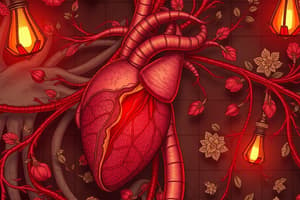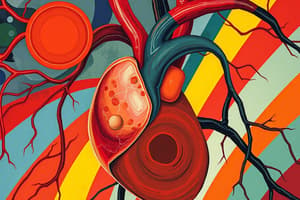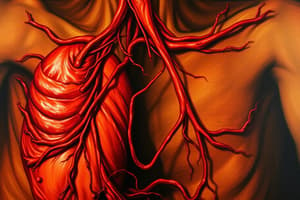Podcast
Questions and Answers
What physiological factor can influence local clotting events without physical disruption of the endothelium?
What physiological factor can influence local clotting events without physical disruption of the endothelium?
- Loss of muscle tone
- Formation of new blood vessels
- Alterations in normal blood flow (correct)
- Elevated blood pressure
Which condition is NOT classified as a condition leading to hypercoagulability?
Which condition is NOT classified as a condition leading to hypercoagulability?
- High blood sugar (correct)
- Prolonged bedrest
- Cancer
- Atrial fibrillation
Where can thrombi develop within the cardiovascular system?
Where can thrombi develop within the cardiovascular system?
- In all parts including cardiac chambers, valves, and capillaries (correct)
- Only in veins
- Only in the aorta
- Only in arteries
What characteristic is commonly associated with arterial thrombi?
What characteristic is commonly associated with arterial thrombi?
What term describes thrombi that are attached to the wall of the heart or aorta?
What term describes thrombi that are attached to the wall of the heart or aorta?
How do venous thrombi primarily differ from arterial thrombi?
How do venous thrombi primarily differ from arterial thrombi?
What is the primary cause of stasis that contributes to venous thrombus formation?
What is the primary cause of stasis that contributes to venous thrombus formation?
Which of these describes a characteristic of thrombi that contain apparent laminations?
Which of these describes a characteristic of thrombi that contain apparent laminations?
What can occur as a result of deep venous thrombosis in larger leg veins?
What can occur as a result of deep venous thrombosis in larger leg veins?
Which condition is most likely associated with cardiac mural thrombi?
Which condition is most likely associated with cardiac mural thrombi?
What mainly contributes to the formation of arterial thrombi?
What mainly contributes to the formation of arterial thrombi?
What characteristic distinguishes venous thrombi from arterial thrombi?
What characteristic distinguishes venous thrombi from arterial thrombi?
What is the definition of an embolus?
What is the definition of an embolus?
In venous thrombosis, which type of vein is most commonly involved?
In venous thrombosis, which type of vein is most commonly involved?
What is the primary role of endothelial cells in hemostasis?
What is the primary role of endothelial cells in hemostasis?
What is the primary concern regarding embolization from venous thrombi?
What is the primary concern regarding embolization from venous thrombi?
Which of the following substances produced by endothelial cells has an antiplatelet effect?
Which of the following substances produced by endothelial cells has an antiplatelet effect?
What role does atherosclerosis play in thrombosis?
What role does atherosclerosis play in thrombosis?
What triggers the procoagulant activities of endothelial cells?
What triggers the procoagulant activities of endothelial cells?
What is the main function of tissue factor in hemostasis?
What is the main function of tissue factor in hemostasis?
How do endothelial cells contribute to fibrinolysis?
How do endothelial cells contribute to fibrinolysis?
What effect does an intact endothelium have on the immune response?
What effect does an intact endothelium have on the immune response?
Which condition might lead to enhanced prothrombotic activities of endothelial cells?
Which condition might lead to enhanced prothrombotic activities of endothelial cells?
Which of the following is NOT a characteristic of normal hemostasis?
Which of the following is NOT a characteristic of normal hemostasis?
What role do platelets play in hemostasis?
What role do platelets play in hemostasis?
Which mediator is primarily involved in platelet adhesion?
Which mediator is primarily involved in platelet adhesion?
What is the purpose of ADP in platelet aggregation?
What is the purpose of ADP in platelet aggregation?
How does thrombin contribute to the stability of the hemostatic plug?
How does thrombin contribute to the stability of the hemostatic plug?
What result does the interaction of thrombin with its receptor induce?
What result does the interaction of thrombin with its receptor induce?
What characterizes the primary platelet aggregation?
What characterizes the primary platelet aggregation?
What describes the coagulation cascade?
What describes the coagulation cascade?
What is the final product of the coagulation cascade?
What is the final product of the coagulation cascade?
What is the primary source of venous emboli in over 95% of cases?
What is the primary source of venous emboli in over 95% of cases?
What is a common consequence of pulmonary embolism when 60% or more of the pulmonary circulation is obstructed?
What is a common consequence of pulmonary embolism when 60% or more of the pulmonary circulation is obstructed?
Which of the following conditions is NOT a predisposing factor for deep vein thrombosis (DVT)?
Which of the following conditions is NOT a predisposing factor for deep vein thrombosis (DVT)?
What percentage of systemic thromboembolism is associated with left ventricular wall infarcts?
What percentage of systemic thromboembolism is associated with left ventricular wall infarcts?
What treatment is commonly used for deep vein thrombosis?
What treatment is commonly used for deep vein thrombosis?
What is the annual death toll attributed to pulmonary embolism in the United States?
What is the annual death toll attributed to pulmonary embolism in the United States?
What is a common consequence of fat embolism from fractures of long bones?
What is a common consequence of fat embolism from fractures of long bones?
Which of the following is a major site affected by systemic thromboembolism?
Which of the following is a major site affected by systemic thromboembolism?
What is the role of antithrombins in the clotting process?
What is the role of antithrombins in the clotting process?
Which proteins are involved in the inactivation of cofactors Va and VIIIa?
Which proteins are involved in the inactivation of cofactors Va and VIIIa?
What initiates the generation of plasmin from plasminogen?
What initiates the generation of plasmin from plasminogen?
What prevents free plasmin from indiscriminate lysing of thrombi in the body?
What prevents free plasmin from indiscriminate lysing of thrombi in the body?
What are the primary influences on thrombus formation known as Virchow's triad?
What are the primary influences on thrombus formation known as Virchow's triad?
What is the primary function of fibrinolysis?
What is the primary function of fibrinolysis?
How is plasminogen activated to plasmin?
How is plasminogen activated to plasmin?
What is the function of tissue factor pathway inhibitor (TFPI)?
What is the function of tissue factor pathway inhibitor (TFPI)?
Flashcards
Embolus
Embolus
A blood clot that travels through the bloodstream and can obstruct blood flow in distant vessels.
Embolism
Embolism
A detached intravascular solid, liquid, or gaseous mass that is carried by the blood to a site distant from its point of origin.
Embolization
Embolization
The process of a blood clot breaking apart and forming smaller pieces that can travel through the bloodstream.
Venous Thrombosis
Venous Thrombosis
Signup and view all the flashcards
Arterial Thrombosis
Arterial Thrombosis
Signup and view all the flashcards
Cardiac Mural Thrombus
Cardiac Mural Thrombus
Signup and view all the flashcards
Dissolution
Dissolution
Signup and view all the flashcards
Organization and recanalization
Organization and recanalization
Signup and view all the flashcards
Endothelium and Thrombosis
Endothelium and Thrombosis
Signup and view all the flashcards
Turbulence and Thrombosis
Turbulence and Thrombosis
Signup and view all the flashcards
Stasis and Venous Thrombi
Stasis and Venous Thrombi
Signup and view all the flashcards
What is Hypercoagulability?
What is Hypercoagulability?
Signup and view all the flashcards
Primary Hypercoagulability
Primary Hypercoagulability
Signup and view all the flashcards
Secondary Hypercoagulability
Secondary Hypercoagulability
Signup and view all the flashcards
Thrombus Location and Size
Thrombus Location and Size
Signup and view all the flashcards
Lines of Zahn
Lines of Zahn
Signup and view all the flashcards
Natural Anticoagulants
Natural Anticoagulants
Signup and view all the flashcards
Antithrombin
Antithrombin
Signup and view all the flashcards
Hemostasis
Hemostasis
Signup and view all the flashcards
Proteins C and S
Proteins C and S
Signup and view all the flashcards
Thrombosis
Thrombosis
Signup and view all the flashcards
Tissue Factor Pathway Inhibitor (TFPI)
Tissue Factor Pathway Inhibitor (TFPI)
Signup and view all the flashcards
Fibrinolysis
Fibrinolysis
Signup and view all the flashcards
Endothelium
Endothelium
Signup and view all the flashcards
Plasminogen
Plasminogen
Signup and view all the flashcards
Antithrombotic Properties
Antithrombotic Properties
Signup and view all the flashcards
Prothrombotic Properties
Prothrombotic Properties
Signup and view all the flashcards
Plasminogen Activators (PAs)
Plasminogen Activators (PAs)
Signup and view all the flashcards
Endothelial Injury
Endothelial Injury
Signup and view all the flashcards
Prostacyclin (PGI2)
Prostacyclin (PGI2)
Signup and view all the flashcards
Heparin-like Molecules
Heparin-like Molecules
Signup and view all the flashcards
Thrombomodulin
Thrombomodulin
Signup and view all the flashcards
Pulmonary Thromboembolism
Pulmonary Thromboembolism
Signup and view all the flashcards
Pulmonary Embolism
Pulmonary Embolism
Signup and view all the flashcards
Thromboembolism
Thromboembolism
Signup and view all the flashcards
Deep Vein Thrombosis (DVT)
Deep Vein Thrombosis (DVT)
Signup and view all the flashcards
Systemic Thromboembolism
Systemic Thromboembolism
Signup and view all the flashcards
Fat Embolism
Fat Embolism
Signup and view all the flashcards
Silent Pulmonary Embolism
Silent Pulmonary Embolism
Signup and view all the flashcards
Pulmonary Hypertension
Pulmonary Hypertension
Signup and view all the flashcards
Endothelial Cells & Blood Clotting
Endothelial Cells & Blood Clotting
Signup and view all the flashcards
What are platelets?
What are platelets?
Signup and view all the flashcards
Platelet Adhesion
Platelet Adhesion
Signup and view all the flashcards
Platelet Secretion (Release Reaction)
Platelet Secretion (Release Reaction)
Signup and view all the flashcards
Platelet Activation & Phospholipids
Platelet Activation & Phospholipids
Signup and view all the flashcards
Platelet Aggregation
Platelet Aggregation
Signup and view all the flashcards
Coagulation Cascade & Thrombin
Coagulation Cascade & Thrombin
Signup and view all the flashcards
Regulation of Coagulation Cascade
Regulation of Coagulation Cascade
Signup and view all the flashcards
Study Notes
Hemodynamic Disorders, Thrombosis, and Shock
- The health of cells and tissues depends on an intact circulation to deliver oxygen and remove wastes, and on normal fluid homeostasis. Normal fluid homeostasis means maintaining blood as a liquid until clot formation is essential.
- Normal hemostasis results from tightly regulated processes that maintain blood in a fluid, clot-free state in normal vessels, while inducing rapid formation of a localized hemostatic plug at the site of vascular injury.
- Hemostasis and thrombosis both involve three components: the vascular wall, platelets, and the coagulation cascade.
Hemostasis and Thrombosis: Vasoconstriction
- Vasoconstriction: Endothelin release causes vasoconstriction.
- This reduces blood flow to the injured area, limiting blood loss
Hemostasis and Thrombosis: Primary Hemostasis
- Platelet adhesion: Platelets adhere to the exposed collagen in the vascular wall. Von Willebrand factor facilitates this.
- Shape change: Platelets change shape, becoming stickier.
- Granule release: Platelets release ADP and TXA₂, promoting further platelet aggregation.
- Recruitment: Platelets aggregate (clump together) forming a hemostatic plug.
- This plug stops or slows blood loss.
Hemostasis and Thrombosis: Secondary Hemostasis
- Tissue factor expression: Tissue factor is exposed when the endothelium is damaged.
- Phospholipid complex expression: This enhances interactions between clotting factors.
- Thrombin activation: Thrombin activation leads to fibrin polymerization.
- Fibrin polymerization: Fibrin forms a meshwork, further strengthening the hemostatic plug.
Thrombus and Antithrombotic Events
- Release of t-PA (tissue plasminogen activator): Fibrinolysis(breaking down fibrin) is initiated.
- Thrombomodulin: Blocks coagulation cascade
- Trapped neutrophils & red blood cells: The thrombus becomes visible.
- Polymerized fibrin: The blood clot's final stage
Endothelium
- Endothelial cells modulate (influence and regulate) the opposing aspects of normal hemostasis.
- Anti- and prothrombotic activities of endothelial cells regulate thrombus formation, propagation, or dissolution.
- Endothelial cells have antiplatelet, anticoagulant, and fibrinolytic properties at baseline that can become procoagulant after injury or activation.
Antithrombotic Properties
- Endothelial cells maintain a liquid blood flow environment under most circumstances by blocking platelet adhesion and aggregation, inhibiting the coagulation cascade, and lysing blood clots.
- Antiplatelet effects, anticoagulant effects, and fibrinolytic effects are critical.
Antiplatelets
- In the presence of an intact endothelium, platelets and coagulation factors don't interact with the highly thrombogenic subendothelial ECM.
- Prostacyclin (PGI₂) and nitric oxide.
- Adenosine diphosphatase.
- Heparin-like molecules and thrombomodulin.
Fibrinolytic Properties
- Plasminogen Activator (tPA).
- The Extrinsic coagulation sequence and the tissue factor sequence lead to favoring thrombosis.
- There is also an inhibitory pathway to limit thrombosis.
Prothrombotic Properties
- Endothelial injury leads to platelet adhesion. This is facilitated by von Willebrand factor (vWF).
- Endothelial cells can produce procoagulant effects in response to injury or activation by bacterial endotoxin or cytokines (e.g., TNF, IL-1). Tissue factor is synthesized in these cases.
- Endothelial cells can have antifibrinolytic effects by secreting inhibitors of plasminogen activator (PAIs).
Platelets
- Platelets play a central role in normal hemostasis
- Platelet adhesion to the ECM is primarily mediated by interactions with vWF, acting as a bridge between platelet surface receptors (e.g., Gplb) and exposed collagen.
- Platelet activation increases the expression of phospholipid complexes.
- Dense body contents such as ADP and ATP, calcium, histamine, serotonin, and epinephrine are released.
Platelet Aggregation
- Platelet aggregation follows adhesion and granule release.
- ADP and thromboxane A2 promotes platelet aggregation which forms the primary hemostatic plug.
- This primary aggregation, is reversible.
- Thrombin binding to platelet surface receptors (PARs) leads to irreversible aggregation and platelet contraction, leading to the secondary hemostatic plug. Fibrinogen is converted to fibrin.
Coagulation Cascade
- The coagulation cascade is a series of enzymatic reactions that amplify the activation process.
- Inactive proenzymes are proteolytically cleaved, leading to activated enzymes, eventually resulting in thrombin.
- Thrombin converts soluble fibrinogen into insoluble fibrin, which forms a meshwork entrapping platelets and other cells, creating the secondary hemostatic plug.
- To prevent runaway clotting, the coagulation cascade must be restricted to the injury site with natural anticoagulants.
Antithrombins
- Antithrombins, such as antithrombin III, inhibit thrombin and other serine proteases (factors IXa, Xa, Xla, and XIla).
- Proteins C and S are vitamin K-dependent proteins and inactivate cofactors Va and VIIIa.
- Tissue factor pathway inhibitor (TFPI) limits clotting.
Fibrinolysis
- Activation of the clotting cascade initiates a fibrinolytic cascade that limits the size of the clot.
- Plasmin breaks down fibrin and interferes with polymerization
- Plasmin is generated by enzymatic degradation of plasminogen, activated by factor XII-dependent pathways or by plasminogen activators (t-PA being most important).
Thrombosis
- Three primary influences (Virchow's triad) affect thrombus formation: endothelial injury, abnormal blood flow (stasis or turbulence), and hypercoagulability.
Thrombosis: Endothelial Injury
- Endothelial injury is important in thrombus formation in the heart or arterial circulation.
- Any disturbance of prothrombotic and antithrombotic activity of endothelium can influence local clotting.
Thrombosis: Abnormal Blood Flow
- Turbulence causes endothelial injury and dysfunction leading to arterial or cardiac thrombosis.
- Stasis is a major factor in venous thrombosis.
Thrombosis: Hypercoagulability
- Hypercoagulability is any alteration of the coagulation pathways that predisposes to thrombosis.
- Can be primary (genetic) or secondary (acquired).
- Examples include factor V Leiden, prothrombin gene mutation, and antithrombin III deficiency
- Secondary examples include prolonged bed rest, myocardial infarction, atrial fibrillation, cancer, disseminated intravascular coagulation etc.
Thrombosis: Morphology
- Thrombi can develop anywhere in the cardiovascular system, influence location & form of thrombus.
- Arterial thrombi typically propagate retrograde, while venous thrombi extend in the direction of blood flow.
- Thrombi can have grossly or microscopically visible laminations called lines of Zahn.
- Mural thrombi refer to thrombi in the heart chambers or the aorta lumen.
Thrombosis: Arterial Thrombi
- Arterial thrombi are frequently occlusive and consist of a friable meshwork of platelets, fibrin, erythrocytes and altered leukocytes.
- Thrombosis in the major arteries is clinically significant.
Thrombosis: Venous Thrombi
- Venous thrombi, largely the result of coagulation cascade activation, are usually occlusive.
- Platelets play a secondary role.
- Venous thrombi contain more enmeshed erythrocytes, often called "red" or "stasis" thrombi.
- Venous thrombi are frequently associated with slow or sluggish blood flow.
Fate of the Thrombus
- Propagation
- Embolisation
- Dissolution
- Organization and recanalization
Emboli
- An embolus is a detached intravascular solid, liquid, or gaseous mass carried by the blood to a distant site of origin.
- A majority (99%) of emboli originate as dislodged thrombi (thromboembolism).
Pulmonary Thromboembolism
- Has incidence rate of 20 to 25 cases per 100,000 hospitalized patients.
- Deep leg vein thrombi above the knee are the source.
- Most pulmonary emboli (60%–80%) are clinically silent.
- Consequences include ischemic necrosis of downstream tissue and sudden death/right ventricular failure.
Systemic Thromboembolism
- Systemic thromboembolism refers to emboli in the arterial circulation.
- Most (80%) originate from intracardiac mural thrombi.
- Common sites for arterial embolization include lower extremities and brain.
Predisposing Factors for Deep Vein Thrombosis
- Immobility
- Pregnancy
- Post-operative
- Severe burns
- Heart failure
- Cancer
Prophylaxis & Treatment for Deep Vein Thrombosis (DVT)
- High-risk patients should undergo prophylaxis (Heparin, leg compression).
- Treatment involves intravenous heparin and warfarin.
Other Types of Emboli
- Fat embolism (fat globules in the circulation, after fractures or trauma)
- Air embolism (air bubbles obstructing vascular flow, during obstetric procedures or chest wall injuries).
- Amniotic fluid embolism (a rare, serious complication of labor and postpartum).
Clinical Correlations (Venous vs. Arterial Thrombosis)
- Venous thrombi obstruct distal blood vessels and can embolize to the lungs.
- Arterial thrombi are more clinically relevant due to their ability to produce tissue infarction at critical sites like coronary and cerebral vessels.
Studying That Suits You
Use AI to generate personalized quizzes and flashcards to suit your learning preferences.




